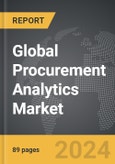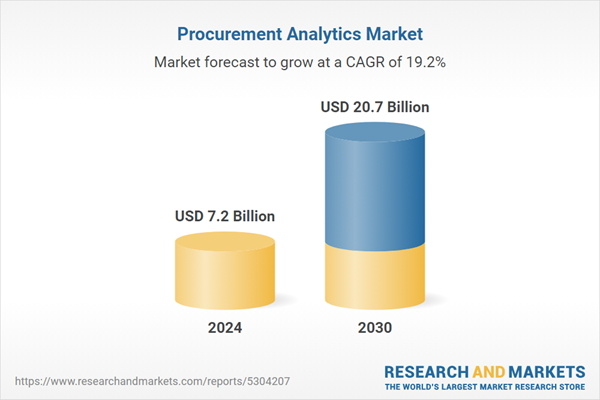Global Procurement Analytics Market - Key Trends & Drivers Summarized
How is Procurement Analytics Reshaping Supply Chain Management?
Procurement analytics is transforming supply chain management by enabling companies to make data-driven decisions throughout their procurement processes. By leveraging advanced data analytics, companies can gain insights into supplier performance, pricing trends, spending patterns, and potential risks, allowing for more informed decision-making and strategic planning. Traditionally, procurement involved a substantial amount of manual data processing, making it challenging to gain real-time insights into spending or identify patterns. With procurement analytics, companies can access consolidated data across multiple suppliers, categories, and regions, providing a clear picture of where resources are being allocated and identifying opportunities for cost savings. Through dashboards and visual reports, procurement teams can track KPIs such as cost per unit, order cycle times, and compliance rates, enabling more agile and responsive supply chain management.Moreover, procurement analytics helps businesses mitigate risks by identifying supplier dependencies, potential disruptions, and compliance issues. With predictive analytics, companies can anticipate supply chain interruptions, assess the financial stability of suppliers, and adjust sourcing strategies proactively. This capability is particularly valuable in volatile markets, where supply chain disruptions can have a significant impact on operations. By incorporating procurement analytics, companies are not only optimizing their spending but also gaining a strategic advantage, as they can better forecast demand, negotiate better terms, and maintain stronger, more resilient supply chains.
What Role Does Technology Play in the Advancement of Procurement Analytics?
Technological advancements have been a driving force behind the growth of procurement analytics, with AI, machine learning, and big data at the forefront of innovation. Modern procurement analytics platforms leverage AI and machine learning algorithms to automatically categorize and analyze vast amounts of procurement data, identifying patterns that would be impossible for humans to detect. For example, machine learning algorithms can process historical spend data and suggest optimal sourcing strategies, helping companies reduce costs and improve supplier selection. In addition, natural language processing (NLP) is being used to analyze unstructured data from contract documents and supplier communications, extracting insights related to compliance and contract performance.The adoption of cloud computing has further accelerated the use of procurement analytics by allowing companies to integrate data from multiple systems and locations seamlessly. Cloud-based procurement platforms enable real-time collaboration among procurement teams, suppliers, and stakeholders, providing access to the latest data regardless of location. Furthermore, these platforms offer scalability, allowing companies to start with a few critical analytics functions and expand their capabilities over time as their procurement needs grow. As more companies integrate IoT devices within their supply chains, the amount of real-time data available for analysis is increasing, enabling procurement teams to track shipments, monitor inventory levels, and adjust sourcing plans with unprecedented accuracy and speed. Together, these technologies are making procurement analytics a more powerful tool for strategic decision-making and competitive advantage.
Why Are Organizations Increasingly Adopting Procurement Analytics Solutions?
Organizations are adopting procurement analytics solutions to improve visibility into their spending, streamline sourcing processes, and ultimately gain a competitive edge. In today's dynamic market, the ability to access real-time, actionable insights is invaluable for identifying areas where costs can be optimized and efficiencies improved. By providing detailed analytics on spending trends, supplier performance, and contract compliance, procurement analytics allows companies to align their sourcing strategies with broader business goals. For instance, companies can analyze spending by category to identify areas of excessive cost, enabling them to consolidate suppliers, negotiate volume discounts, or find alternative sources. This level of insight helps companies maximize the value of every dollar spent, which is critical for maintaining profitability in competitive markets.Additionally, procurement analytics supports organizations in achieving sustainability and corporate social responsibility (CSR) goals by providing visibility into their supply chains. By analyzing supplier data, companies can evaluate the environmental impact and labor practices of their suppliers, ensuring alignment with CSR objectives. This transparency allows companies to make more ethical sourcing decisions, enhancing their brand reputation and aligning with the growing consumer demand for responsible practices. Furthermore, as regulatory requirements around supplier transparency and environmental impact become stricter, procurement analytics offers companies a reliable way to meet these standards. The convergence of cost optimization, compliance, and ethical considerations is driving a strong demand for procurement analytics as organizations recognize its value beyond traditional cost management.
What Factors Are Driving Growth in the Procurement Analytics Market?
The growth in the procurement analytics market is driven by factors such as the need for cost control, the growing complexity of supply chains, and advancements in data analytics technology. With increasing pressure to optimize operational efficiency, companies are turning to procurement analytics to gain control over their spending and identify cost-saving opportunities. Rising competition across industries has heightened the focus on procurement as a strategic function, with analytics enabling companies to make data-backed decisions that improve their competitive positioning. The complex, globalized nature of modern supply chains has also made procurement analytics essential, as companies need a clear understanding of supplier networks, risk exposure, and sourcing costs to manage disruptions effectively.Technological advancements, including AI, machine learning, and the rise of cloud-based platforms, have made procurement analytics more accessible and powerful. As these technologies become more sophisticated, companies can leverage deeper insights to optimize their sourcing strategies, mitigate risks, and maintain compliance with evolving regulatory requirements. Additionally, the trend toward sustainability and ethical sourcing is driving companies to adopt procurement analytics solutions that can monitor supplier practices, carbon footprint, and overall environmental impact. Finally, the increased emphasis on digital transformation in organizations has led to more integration of procurement analytics into enterprise resource planning (ERP) and supply chain management systems, reinforcing its role as a critical tool in modern business operations. These combined factors are fueling robust growth in the procurement analytics market, making it an indispensable component for forward-thinking organizations.
Report Scope
The report analyzes the Procurement Analytics market, presented in terms of market value (US$ Thousand). The analysis covers the key segments and geographic regions outlined below.- Segments: Component (Solutions, Services); Deployment (On-Premise, Cloud); Vertical (BFSI, Telecom & IT, Manufacturing, Energy & Utilities, Retail & eCommerce, Healthcare & Life Sciences, Government & Defense).
- Geographic Regions/Countries:World; United States; Canada; Japan; China; Europe (France; Germany; Italy; United Kingdom; Spain; Russia; and Rest of Europe); Asia-Pacific (Australia; India; South Korea; and Rest of Asia-Pacific); Latin America (Argentina; Brazil; Mexico; and Rest of Latin America); Middle East (Iran; Israel; Saudi Arabia; United Arab Emirates; and Rest of Middle East); and Africa.
Key Insights:
- Market Growth: Understand the significant growth trajectory of the Procurement Analytics Solutions segment, which is expected to reach US$12.3 Billion by 2030 with a CAGR of a 18.7%. The Procurement Analytics Services segment is also set to grow at 20% CAGR over the analysis period.
- Regional Analysis: Gain insights into the U.S. market, valued at $1.8 Billion in 2024, and China, forecasted to grow at an impressive 24.8% CAGR to reach $5.5 Billion by 2030. Discover growth trends in other key regions, including Japan, Canada, Germany, and the Asia-Pacific.
Why You Should Buy This Report:
- Detailed Market Analysis: Access a thorough analysis of the Global Procurement Analytics Market, covering all major geographic regions and market segments.
- Competitive Insights: Get an overview of the competitive landscape, including the market presence of major players across different geographies.
- Future Trends and Drivers: Understand the key trends and drivers shaping the future of the Global Procurement Analytics Market.
- Actionable Insights: Benefit from actionable insights that can help you identify new revenue opportunities and make strategic business decisions.
Key Questions Answered:
- How is the Global Procurement Analytics Market expected to evolve by 2030?
- What are the main drivers and restraints affecting the market?
- Which market segments will grow the most over the forecast period?
- How will market shares for different regions and segments change by 2030?
- Who are the leading players in the market, and what are their prospects?
Report Features:
- Comprehensive Market Data: Independent analysis of annual sales and market forecasts in US$ Million from 2024 to 2030.
- In-Depth Regional Analysis: Detailed insights into key markets, including the U.S., China, Japan, Canada, Europe, Asia-Pacific, Latin America, Middle East, and Africa.
- Company Profiles: Coverage of players such as BirchStreet, BRIDGEi2i, Coupa Software, Genpact, Jaggaer and more.
- Complimentary Updates: Receive free report updates for one year to keep you informed of the latest market developments.
Some of the 34 companies featured in this Procurement Analytics market report include:
- BirchStreet
- BRIDGEi2i
- Coupa Software
- Genpact
- Jaggaer
- Oracle
- Proactis
- Rosslyn Data Technologies
- SAP
- SAS
- Sievo
- Simfoni
- Tamr
- Zycus
This edition integrates the latest global trade and economic shifts into comprehensive market analysis. Key updates include:
- Tariff and Trade Impact: Insights into global tariff negotiations across 180+ countries, with analysis of supply chain turbulence, sourcing disruptions, and geographic realignment. Special focus on 2025 as a pivotal year for trade tensions, including updated perspectives on the Trump-era tariffs.
- Adjusted Forecasts and Analytics: Revised global and regional market forecasts through 2030, incorporating tariff effects, economic uncertainty, and structural changes in globalization. Includes historical analysis from 2015 to 2023.
- Strategic Market Dynamics: Evaluation of revised market prospects, regional outlooks, and key economic indicators such as population and urbanization trends.
- Innovation & Technology Trends: Latest developments in product and process innovation, emerging technologies, and key industry drivers shaping the competitive landscape.
- Competitive Intelligence: Updated global market share estimates for 2025, competitive positioning of major players (Strong/Active/Niche/Trivial), and refined focus on leading global brands and core players.
- Expert Insight & Commentary: Strategic analysis from economists, trade experts, and domain specialists to contextualize market shifts and identify emerging opportunities.
Table of Contents
Companies Mentioned (Partial List)
A selection of companies mentioned in this report includes, but is not limited to:
- BirchStreet
- BRIDGEi2i
- Coupa Software
- Genpact
- Jaggaer
- Oracle
- Proactis
- Rosslyn Data Technologies
- SAP
- SAS
- Sievo
- Simfoni
- Tamr
- Zycus
Table Information
| Report Attribute | Details |
|---|---|
| No. of Pages | 373 |
| Published | January 2026 |
| Forecast Period | 2024 - 2030 |
| Estimated Market Value ( USD | $ 7.2 Billion |
| Forecasted Market Value ( USD | $ 20.7 Billion |
| Compound Annual Growth Rate | 19.2% |
| Regions Covered | Global |









